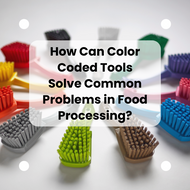30th Aug 2024
Discover how color-coded tools are revolutionizing food processing facilities by tackling common challenges effectively.
Food processing facilities face numerous challenges that can compromise product safety and operating efficiency. Color-coded tools are one such innovation, offering practical answers to some of the most common issues in food processing. Let’s explore how these tools can help solve specific problems and enhance overall safety and efficiency in your facility
Combatting Condensation: The Role of Color-Coded Tools
Excess Condensation is a prevalent issue in food processing facilities, particularly in areas with varying temperatures or high humidity. Excess moisture can lead to the growth of bacteria, mold, and other contaminants, compromising food safety. Condensation can create slippery surfaces, increasing the risk of accidents and further contamination.
There are several different solutions to mitigate a problem with condensation in a working environment. There are many different tools and technologies to control condensation!
Condensation Squeegee features drain holes that allow condensation to be collected safely in a bottle or drained away through an attached hose. Long poles, used to reach ceilings and pipes,make hard-to-reach areas more accessible. (See Condensation Squeegee Accessories).
Floor Squeegees manage moisture to keep floors dry and reduce the risk of slips and falls. Removing excess water from the working environments prevents the spread of bacteria and mold that thrive in wet conditions.
While it’s not a tool per se, dehumidifiers help control the amount of moisture in the air. Reducing humidity levels helps prevent the formation of condensation in the first place, making it easier to maintain a dry and safe processing environment.
Enhancing Detectability: The Importance of Fully Metal Detectable Color-Coded Tools
In the food processing industry, the presence of foreign objects in food products is a serious concern. Metal-detectable tools are designed to prevent such contaminants from entering the food supply. However, some tools contain parts or pieces that are not metal-detectable, creating potential risks if these components break off and contaminate the product.
By using fully metal-detectable products, facilities can enhance their safety protocols and reduce the likelihood of contamination. One-piece Fully Metal metal-detectable tools are designed without any non-metal components, ensuring that the entire tool is detectable by standard metal detection systems. We have a broad variety of types of fully metal-detectable tools that can also be color-coded to adhere to protocols and color-coded cleaning plans!
Facilities should consider using metal-detectable versions of items like pens and gloves. These items are often overlooked but can pose a contamination risk if they contain undetectable components.
Optimizing Storage and Cleaning: Solutions with Color-Coded Tools
Proper cleaning and storage of tools are important for maintaining hygiene and organization. In food processing facilities, cleanliness and proper storage of tools are critical to maintaining a hygienic environment and preventing cross-contamination. Improper cleaning and storage can lead to tools harboring bacteria, mold, and other contaminants, which pose a significant risk to food safety. When tools are left uncleaned or stored haphazardly, they can become breeding grounds for harmful pathogens, which can easily transfer to food products, equipment, or surfaces.
To mitigate these risks, implementing structured storage solutions such as shadow boards, wall brackets, and other organizational tools is essential. These solutions not only promote hygiene but also enhance the overall efficiency and safety of the facility.
Color-coded wall brackets are an effective way to organize tools based on their use or the area where they are meant to be used. By assigning specific colors to different areas or types of tasks, food processing facilities can easily prevent cross-contamination. Clear distinctions in color help staff quickly identify the right tool for the job, reducing the risk of cross-contamination.
Shadow boards are designed to keep tools in their designated places with a visual outline of each tool, making it immediately noticeable if something is missing or out of place. This helps to ensure that tools are always returned to their proper location after use, reducing the chances of cross-contamination by preventing misplaced or shared tools from being used in different areas.
Beyond shadow boards and wall brackets, various other storage solutions can be employed to enhance cleanliness and organization. For instance, using color-coded bins or racks can further streamline the cleaning process and ensure that tools are stored in a manner that supports hygiene and safety standards.
Ensuring tools are stored properly in a clean, secure area promotes good hygiene and prolongs their lifespan. It's advisable to keep tools confined to their designated spots. You can find a range of color-coded wall brackets that make it easy to organize brushes, squeegees, brooms, dust pans, and other color-coded equipment.
Breaking Language Barriers: How Color-Coded Tools Improve Communication
Food processing facilities often employ a diverse workforce, where language barriers can pose significant challenges. Miscommunications and misunderstandings can lead to errors, inefficiencies, and safety risks.
Color-coded tools help bridge this gap by providing a universal visual language that all workers can understand, regardless of their native language. By assigning specific colors to different tasks or areas, workers can easily understand their responsibilities and the correct tools to use. This reduces the need for verbal or written instructions, which can be misinterpreted due to language differences.
For example, red tools might be designated for cleaning areas that handle allergens, while green tools are used for general cleaning. Workers quickly learn these associations, reducing errors and improving efficiency.
